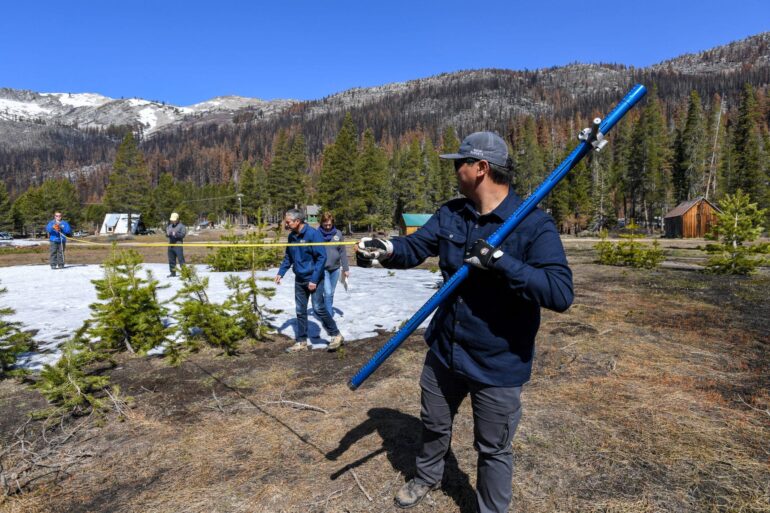In April 2022, a team of engineers hiked into California’s Sierra Nevada mountains to hunt for snow. Instead, they found mostly bare, dry dirt and only a few of the snow patches that provide one-third of California’s water supply.
In the coming decades, water scarcity and insecurity are likely to intensify across much of the United States. In California, the Sierra Nevadas are expected to lose a staggering 65% of their snowpack over the next century, said Hariswaran (Hari) Sitaraman, a researcher at the National Renewable Energy Laboratory. That loss, plus political, economic, and other challenges, is making it essential for drought-prone states, like California, to tap alternative water sources such as brackish (or salty) waters and agricultural runoff.
And yet, the most common way to treat and reuse nontraditional water supplies is through a process called reverse osmosis, which can be both expensive and energy intensive.
Now, Sitaraman and Ilenia Battiato, two members of the National Alliance for Water Innovation (NAWI) research consortium, have used supercomputers to study reverse osmosis systems as a whole—a first for both the type and scale of reverse osmosis research. With their new technique, the duo also discovered a new system design that could make these technologies about 40% more energy efficient—and therefore more cost-effective—while producing the same amount and quality of clean drinking water.
“Until now, people have been looking at a tiny piece of the entire reverse osmosis module and drawing conclusions from that,” Sitaraman said. “But we looked at the entire thing.”
The results are published in a new paper in the journal Separation and Purification Technology.
Along with Battiato, an assistant professor of energy science and engineering at Stanford University, Sitaraman created a fluid dynamics solver—a numerical tool that can analyze how fluids, like salty water, flow into a reverse osmosis system, pass through several membrane filters, and come out clean on the other side.
With their solver, Sitaraman and Battiato studied reverse osmosis systems with high precision, enabling them to uncover any snags or inefficiencies. For example, to filter brackish waters, reverse osmosis systems use high pressure to push the water through several membranes, which, like sophisticated coffee filters, block salts and other minerals from passing through. That process cleans the water, but it also creates thin layers of salty buildup on the membranes. And that buildup can affect how well the water flows, potentially reducing the system’s efficiency.
“That thin layer needs to be measured correctly to understand how much pure water you get out of salt water,” Sitaraman said. “If you don’t capture that right, you cannot understand how much it costs to run a reverse osmosis plant.”
A more efficient reverse osmosis system is more cost-effective, too.
Yet, most reverse osmosis plant owners do not have a high-performance computer to replicate Sitaraman and Battiato’s high-fidelity simulations—which so accurately mimic real-life reverse osmosis technologies—to uncover snags in their own systems. So, Sitaraman performed the complex work of creating a simpler model equation that can predict a system’s mass transfer, estimating how much pure water can be filtered out of brackish water. With his model, engineers can now discover how to improve the efficiency (and cost) of their own systems.
“If the economics improve,” Sitaraman said, “then of course reverse osmosis systems will be more widely used. And if they’re more energy efficient, they will contribute less to greenhouse gas emissions and climate change.”
That is a huge win, but Sitaraman and Battiato’s tools can benefit far more than reverse osmosis plant owners. Other researchers can build on their work to study the efficiency and cost of all kinds of reverse osmosis filtration technologies beyond those used to treat unconventional water sources. The food industry uses these filters to create highly concentrated fruit juices, more flavorful cheeses, and much more. Aquariums need them to remove harmful chemicals from their waters. And reverse osmosis systems can even extract valuable minerals and other substances that could be used to make cheap fertilizer or fuel.
One huge advantage of high-fidelity simulations, Battiato said, is the ability to study a vast range of reverse osmosis system configurations without investing the time and money required to build and experiment with real-life systems.
“We want the system to correctly capture the physics,” Battiato said, “but we are theoretically not constrained by manufacturing.”
With simulations, the team can quickly explore far more potential designs and home in on the best. That is how Battiato and Sitaraman identified their potentially more effective arrangement of spacers (which are bits within the reverse osmosis system that create turbulence and keep channels open to help water flow through). Their new spacer arrangement not only improves the system’s energy efficiency by 40%, but it also produces the same amount of equally pure water.
Although the duo’s simulations accurately replicate real-life systems, they are still theoretical. Sitaraman hopes another research team will build their design and evaluate how closely the real system matches their models. In the meantime, their higher-resolution (or more precise and comprehensive) simulations could help researchers avoid making inaccurate assumptions about how reverse osmosis systems work and, in so doing, learn how to improve the technologies.
Today, most engineers use trial and error to discover how to improve their reverse osmosis systems. But that process is slow, and water shortages are coming fast. With Battiato and Sitaraman’s simulations, engineers could speed up the development of more efficient and cost-effective technologies, so the country can access unconventional water sources when communities—like drought-stricken western towns—desperately need them.
“Water is a scarce resource,” Battiato said. “I don’t think we can afford to do coarse optimization anymore. We need to save every drop of water that we can.”
More information:
Hariswaran Sitaraman et al, Impact of large-scale effects on mass transfer and concentration polarization in Reverse Osmosis membrane systems, Separation and Purification Technology (2022). DOI: 10.1016/j.seppur.2022.122121
Provided by
National Renewable Energy Laboratory
Citation:
New model could help break through inefficiencies of common water treatment systems (2023, January 18)



